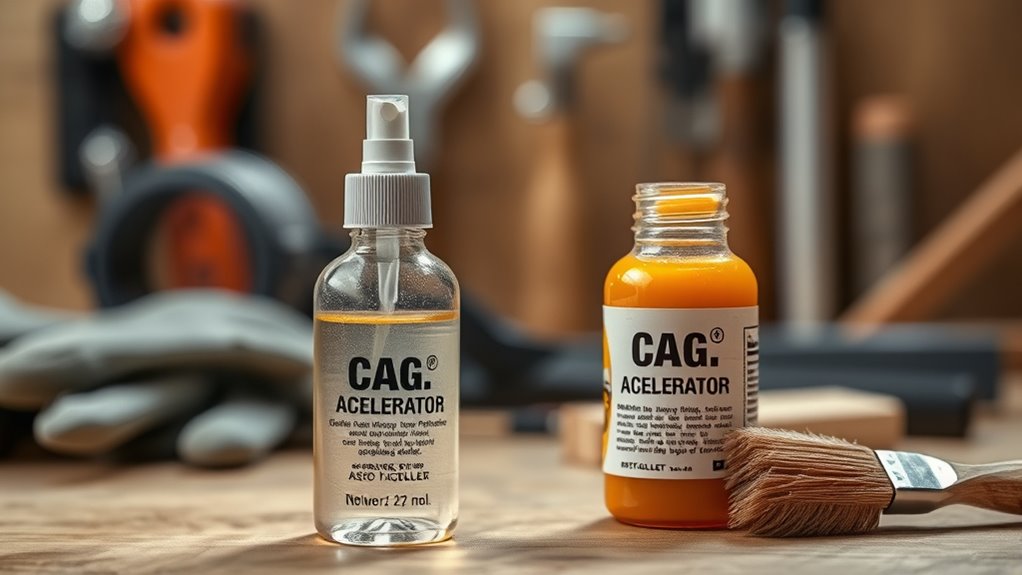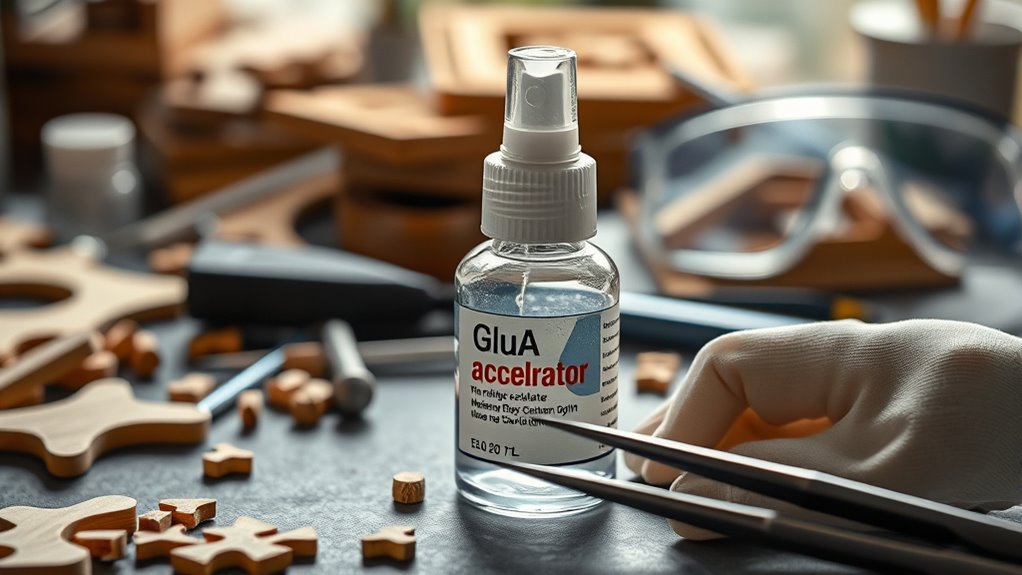To use CA glue accelerators safely, work in a well-ventilated area and wear gloves and safety glasses to avoid contact with skin and eyes. Apply the glue carefully, using small amounts, then lightly mist or dab the accelerator from a safe distance to speed up curing. Avoid overusing it to prevent brittle bonds and fumes. Proper storage and cautious handling help keep your projects safe and effective—continue exploring these tips for ideal results.
Key Takeaways
- Always apply CA glue carefully, then use a light mist or dab of accelerator at a safe distance for quick curing.
- Use accelerators in a well-ventilated area, wearing gloves and safety glasses to prevent skin and eye contact.
- Store accelerators in a cool, dry place, away from flames, heat sources, and out of reach of children and pets.
- Test accelerators on scrap material to determine optimal amount and compatibility before your project.
- Avoid overapplication to prevent brittle bonds, fumes, and potential safety hazards during the gluing process.

Ever wondered how to speed up the curing process of CA glue? Using accelerators can help you achieve quick bonding, but applying them correctly is vital for safety and effectiveness. When it comes to application techniques, it’s best to start with a clean, dry surface. Spray or apply the CA glue first, then lightly mist or dab the accelerator on the bonded area. A common mistake is overusing the accelerator, which can cause the glue to become brittle or create a cloud of fumes. To avoid this, use just a small amount and keep a safe distance when applying. Precision is key—use a fine brush or a spray applicator to target specific spots, especially when working on delicate projects. Remember, the accelerator should complement your application process, not replace careful application of the glue itself. Proper technique can significantly improve the outcome and safety of your project.
Safety precautions are vital anytime you’re working with CA glue accelerators. These products contain chemicals that can irritate your skin, eyes, or respiratory system if mishandled. Always work in a well-ventilated area, and wear protective gloves and safety glasses to prevent accidental contact. Avoid inhaling fumes directly—if you notice strong odors or irritation, step away and increase ventilation. Keep accelerators away from children and pets, as their small size makes them more vulnerable to accidental ingestion or contact. It’s also wise to read the manufacturer’s instructions thoroughly before use. Many accelerators are flammable, so keep them away from open flames or heat sources. Proper storage is equally important—store in a cool, dry place, tightly sealed, and out of reach.
In terms of application techniques, consider testing on scrap material first. This helps you gauge how much accelerator is needed and ensures compatibility with your project. When applying, aim for a light, even spray or dab, rather than soaking the area. This minimizes excess fumes and mess, making your project cleaner and safer. If you’re working on a complex assembly, apply the CA glue first, then use the accelerator to instantly lock components in place. Be mindful of the timing—most accelerators act within seconds, so have everything ready before you start. Clean up spills immediately with a suitable solvent, and dispose of unused accelerators responsibly. Proper handling and adherence to safety precautions will help you use CA glue accelerators effectively, ensuring strong bonds and a safe working environment.
Frequently Asked Questions
CAn CA Glue Accelerators CAuse Skin Irritation or Allergies?
You might wonder if CA glue accelerators can cause skin reactions or allergy symptoms. Yes, they can, especially if you have sensitive skin or allergies. Skin irritation may occur from direct contact, leading to redness, itching, or swelling. To avoid this, wear gloves and work in a well-ventilated area. If you experience allergy symptoms, wash the affected area immediately and seek medical advice if needed.
Are CA Glue Accelerators Safe for Use on Food-Contact Surfaces?
Thinking about slapping CA glue accelerators on your food-contact surfaces? Well, hold your horses! These accelerators aren’t designed for food safety or surface compatibility. Using them on surfaces that touch food can pose health risks, so you shouldn’t. Stick to food-safe adhesives instead. Your culinary creations deserve products tested for surface compatibility and food safety, not quick fixes that might turn your kitchen into a chemical lab.
How Should I Store CA Glue Accelerators to Maximize Shelf Life?
To maximize the shelf life of CA glue accelerators, you should store them in a cool, dry place with a stable storage temperature, ideally between 50-70°F. Always keep the container tightly sealed to prevent moisture and air exposure, which can degrade the product. Avoid storing near heat sources or direct sunlight, as extreme temperatures can cause the accelerator to lose effectiveness over time.
Do CA Glue Accelerators Affect the Strength of the Adhesive Bond?
You might wonder if CA glue accelerators affect bond strength. When used correctly, they don’t weaken the bond but actually improve curing speed, ensuring a quicker and stronger adhesive. However, overusing accelerators can sometimes cause a brittle bond or reduce flexibility. Always follow manufacturer instructions to balance curing speed and bond strength, and avoid excess application to maintain ideal adhesive performance.
CAn CA Glue Accelerators Be Used With All Types of CA Glue?
Ever wonder if CA glue accelerators work with all types? Compatibility concerns can trip you up if you don’t verify first. While many accelerators suit standard cyanoacrylate glues, some formulations, especially thicker or specialty types, may not respond well. To avoid surprises, always review application techniques and manufacturer instructions. Testing a small amount first ensures a perfect bond without risking damage, keeping your project safe and secure.
Conclusion
Remember, using CA glue accelerators wisely turns a quick fix into a lasting bond. Treat these potent tools with respect, for in the wrong hands, they can cause more harm than good—like a double-edged sword. By following safety tips and applying them carefully, you’ll master the art of precise adhesion. So, wield your accelerator with confidence, and let it be the silent hero behind your flawless repairs—proof that knowledge truly is power.









